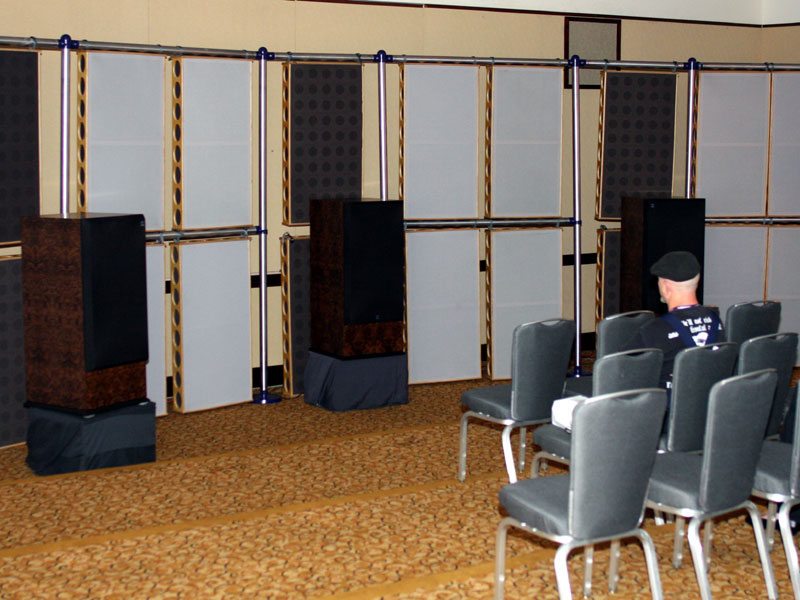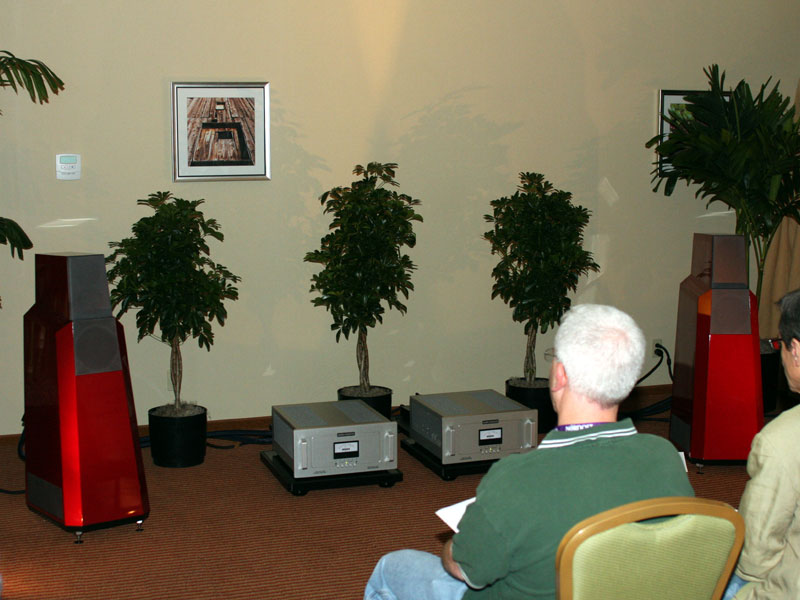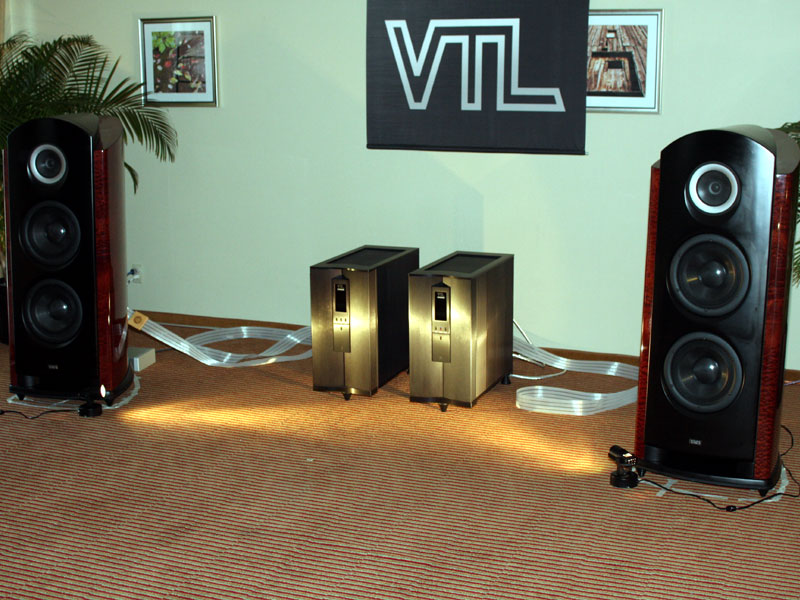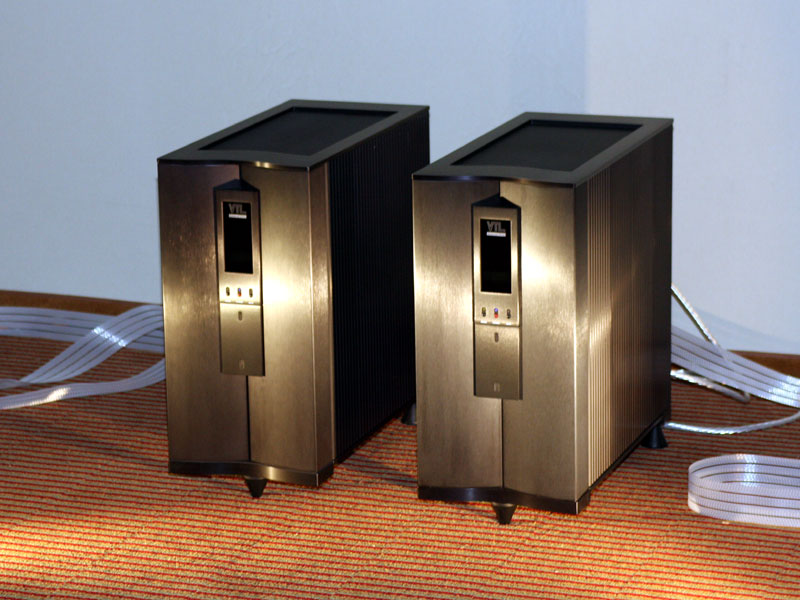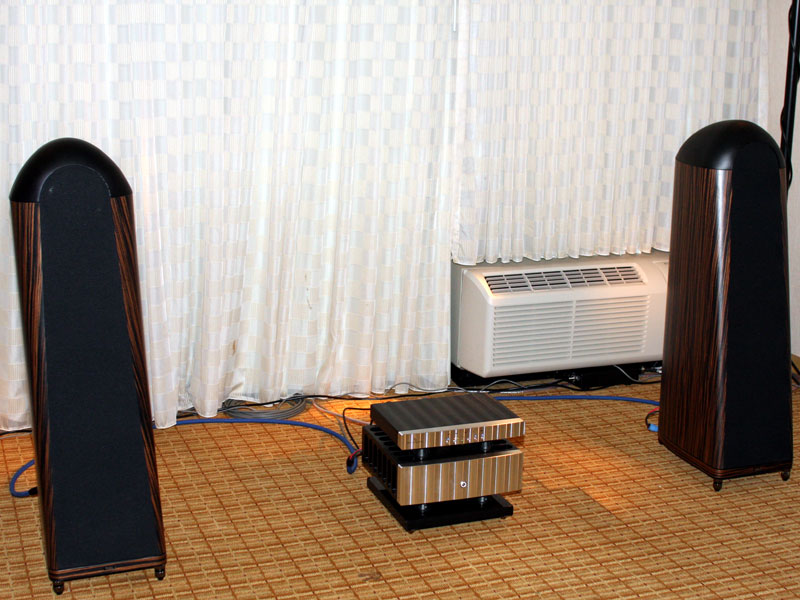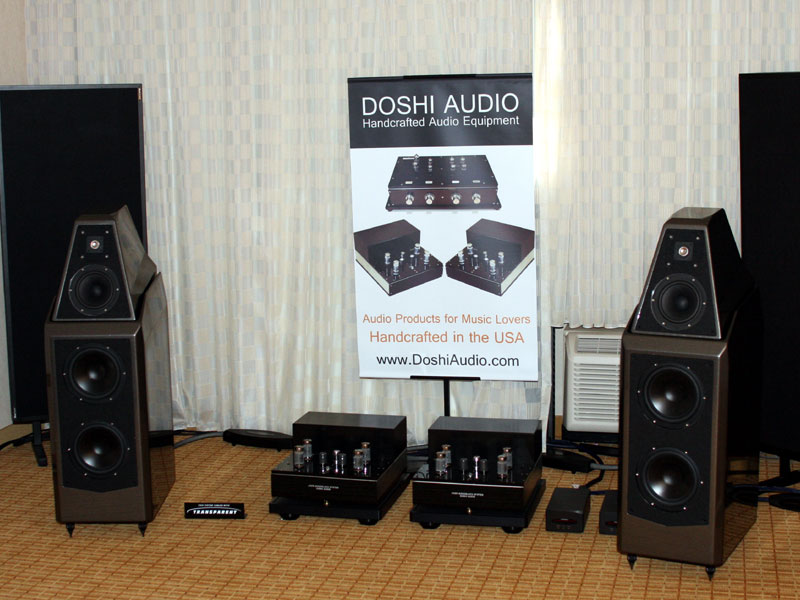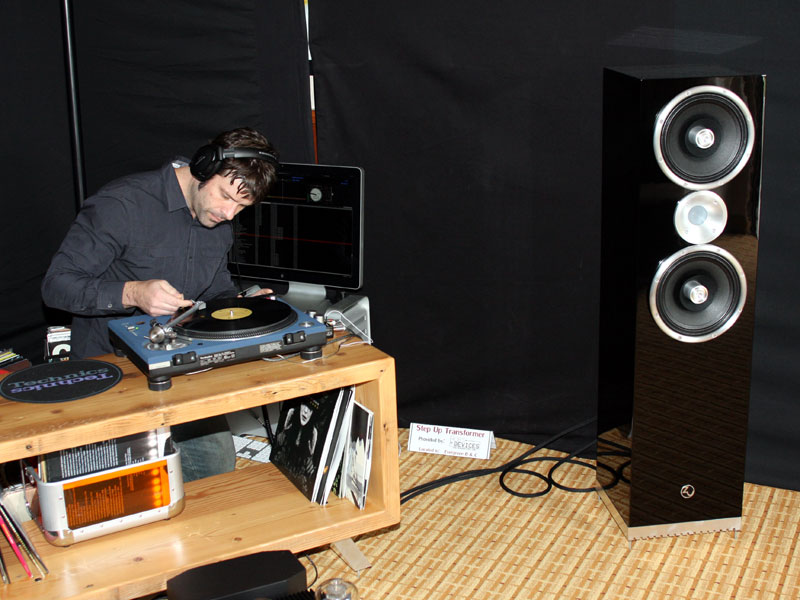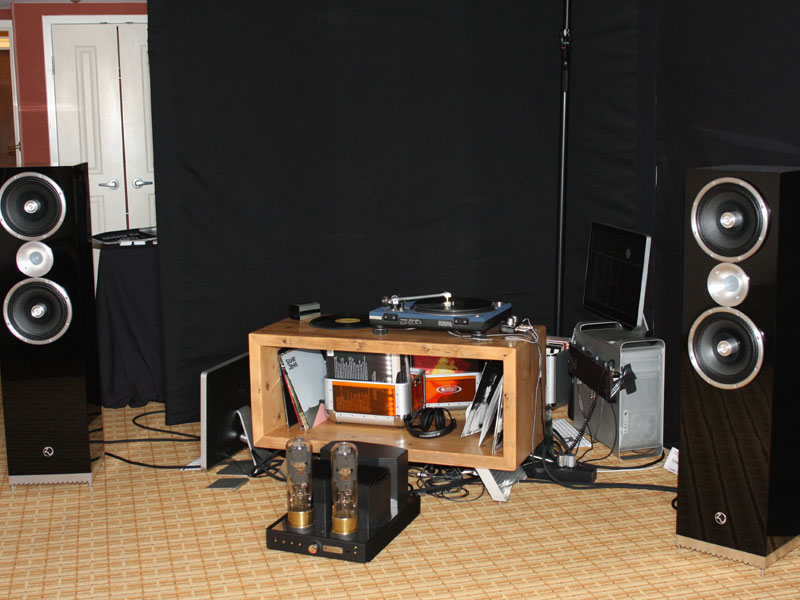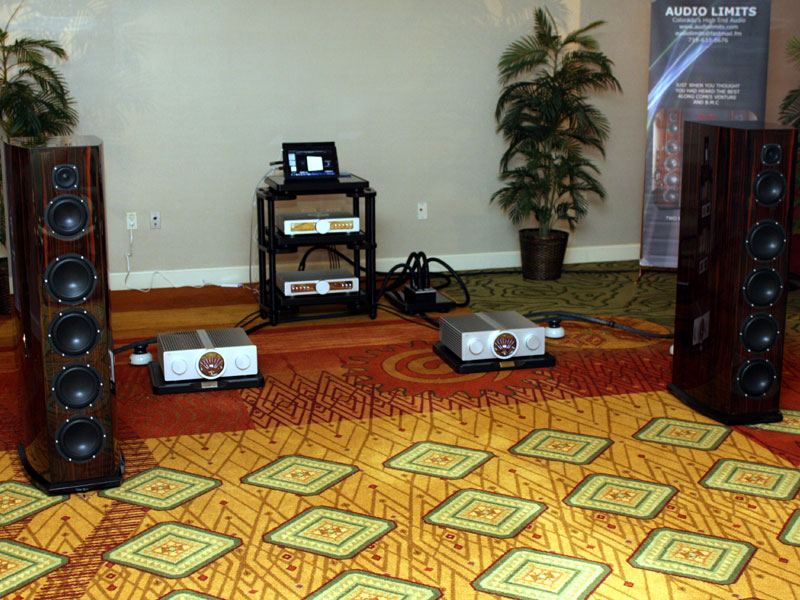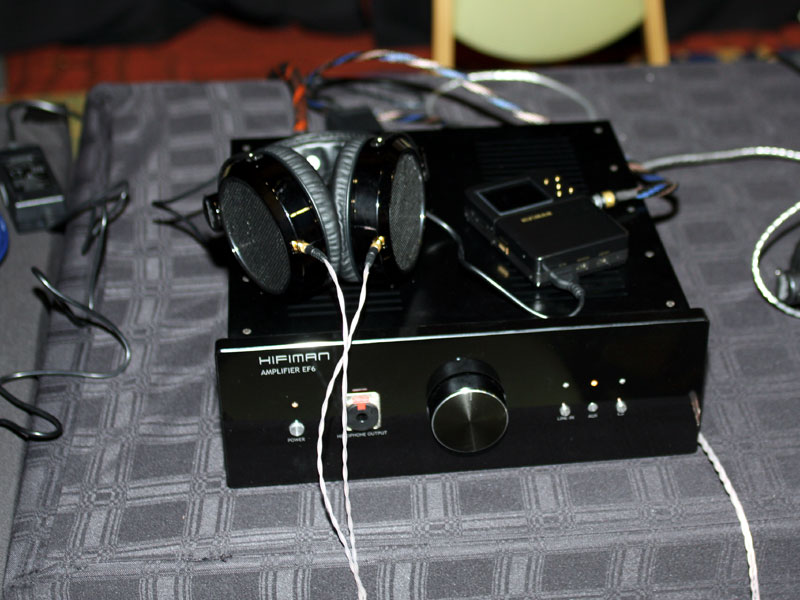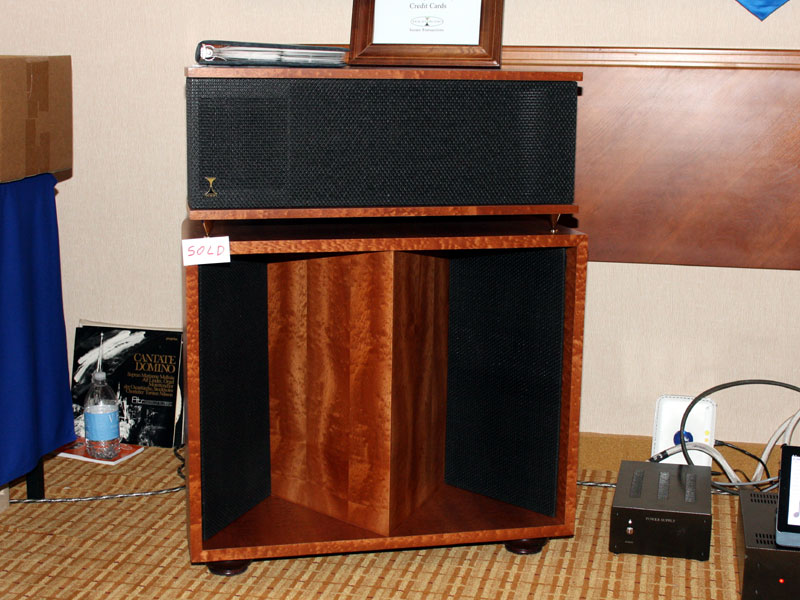Rocky Mountain Audio Fest 2011 • A Weekend of Spectacular Sound
The Rocky Mountain Audio Fest began as a nice little regional audio show, but in the last ten years it has grown into the second most important audio show in the US, behind only the CES. When Marc Mickelson and I were walking around the Denver Tech Center Marriott late Friday morning after picking up our press badges, we were both somewhat nonplussed to see the registration line stretching well out the door and down the hotel’s lengthy drive-up lane. My, how RMAF has grown. The show now incorporates the very substantial CanJam headphone "meet" -- which seems to attract 20-something music lovers in droves -- and is now sufficiently large that it is a real challenge to hear everything in the course of three jam-packed days. And there was a lot to hear.
Getting the show’s most amazing presentation out of the way first, it is nearly impossible to overstate the impact of Acoustic Sounds’ world debut of the 5.1-channel remix of Pink Floyd’s epochal 1975 album Wish You Were Here. Chad Kassem pulled out all of the stops for this project, and the remix was done by none less than James Guthrie, the brilliant recording/mastering engineer and sound designer who has worked on nearly every Floyd and Floyd-related recording and tour for 35 years. Guthrie himself presided over the SACD’s debut on a system with five ATC powered monitors identical to those on which he did the remix and a Playback Designs digital front-end. There really aren’t words for how spectacular, and how musically right, Guthrie’s remix was and the quality imbued in every bit of this production. Following the completion of the SACD, which was played from start to finish, my old compadre from Stereophile, John Atkinson, was for the first time in the ten years I have known him, struck speechless. After the music ended, Marc commented to me, "Man, you were zoned out! You were playing air drums and guitar. You were not on this planet!" To be frank, I wasn’t, and I make no apologies for that fact. I have been hearing this music since the day it arrived in my local record store 35 years ago and never imagined anything like this. Guthrie’s expert, musically impeccable multichannel remix added depth and clarity to the superb original, and how he got Richard Wright’s ARP string synthesizer to orbit the room several feet above my head has to be the result of some sort of voodoo. Chad was visibly bursting at the seams at the magnificence of this landmark project. He well deserved to be more than proud of the efforts of everyone involved. Mind-boggling. JoLida made its name with what used to be called "popular priced" tubed electronics that offered exceptional value-for-dollar. They have moved slightly upmarket, but the combination of the Fusion 200 DAC/transport (also known as a CD player, $1699, available in the first quarter of 2012), Fusion tube line stage ($1099) and 200-watt Fusion monoblocks, which prominently feature a pair of massive 211 power tubes per amp ($6000/pair), sounded excellent through Von Schweikert Audio VR-5 Anniversary Mk II speakers ($30,000/pair). That most of the source material was supplied by a United Home Audio Phase9 analog tape deck ($17,000, which appeared in a number of rooms) certainly helped advance the cause. D’Agostino Master Audio Systems and Wilson Audio put on what was surely one of the most audacious demos ever seen at an audio show. A very simple system, relatively speaking, was set up: a dCS Puccini player decoding the peerless original recordings of Wilson’s Peter McGrath, who set up the room in expert fashion, along with the D’Agostino Momentum power amplifiers ($45,000/pair) paired with Wilson’s Sasha W/P loudspeakers ($27,900/pair) and Transparent Audio cabling. What was so audacious? The room treatments, of which there were nada, zip, el zilcho. McGrath’s recordings are so good that failure downstream will be immediately revealed, yet the results were jaw-dropping. A significant slice of Mahler’s Fifth was spine-chillingly realistic and dynamic, as was everything else Peter played, from Yello to Jimmy Smith. I had heard the Momentums sound quite marvelous with Sashas at CES in January, but this was special. I will, with any luck, be reporting at considerable length about how the Momentum amps sound on my Sashas sometime after CES 2012.
Denver’s Audio Research and Vandersteen dealer Audio Alternative assembled a most impressive system featuring a full complement of Audio Research electronics and Vandersteen 7 speakers ($50,000/pair) to debut the new Audio Research Reference 250 mono amplifiers ($25,990/pair). Also in attendance were a Spiral Groove SG1.1 turntable with its companion Centroid 'arm and a Lyra Olympos cartridge ($43,000 total), AudioQuest cabling and Harmonic Resolution Systems racking. At the 2010 RMAF, a virtually identical system had failed to quite take flight, dynamically speaking. I attributed this to the deadish room and the insensitivity (83dB) of the Vandersteens, as I had never heard the Reference 210s fail to bounce off the walls any other speaker with which I have heard them paired. This year the Reference 250s lit the wick with power to spare. First-rate soundstaging and detail retrieval were present in full measure, and the dynamic response was all that could be asked for. Audio Research has come up with yet another winner with the Reference 250s.
VTL pulled out all of the stops in its debut of the Siegfried Series II Reference mono amplifiers (650 watts, $65,000/pair). The new Siegfried has been thoroughly rethought, and it now features a fully balanced differential input stage driving a differential phase splitter, a lower-impedance push-pull output stage and a completely new "fully balanced and enhanced interleaved and coupled output transformer." The amp now has zero global negative feedback and adjustable damping as well as Mundorf silver/oil capacitors.
The massive new Siegfrieds were teamed with VTL’s TL-7.5 Series III line preamp ($20,000) and TP-6.5 phono stage, a complete dCS Paganini digital playback system ($53,496 for transport, DAC, clock and upsampler), Spiral Groove’s SG1.1/Centroid pair ($35,000) and a Lyra Skala cartridge ($3200). All of this fronted TAD’s very impressive Reference One loudspeakers ($75,000/pair). Signal cabling was a complete loom of Nordost Odin ($235,000); Nordost also supplied Odin and Valhalla power cords, and an assortment of Quantum QBase power products ($50,000 total) were also in evidence. Not content with this, VTL also brought in mastering supremo Paul Stubblebine and duplication engineer Piper Payne from The Tape Project with a modified Otari MTR-20 tape machine fitted with a Bottlehead Repro output section. Whew! The Tape Project is intimately familiar with the Siegfrieds, as the amps are used during the creation of The Tape Project's limited-edition tapes. As imposing as this system was, the sonics were even more impressive. When Piper cued up the reissue of Nat "King" Cole and George Shearing’s "This Is the End of a Beautiful Friendship," the music simply bloomed effortlessly into the room, utterly unforced and as natural as a gentle autumn breeze. Cole’s voice went down like 30-year old Scotch, and I could easily separate Shearing’s piano from the vibes that were doubling him. Swoon-making to be sure. On Sunday afternoon I stopped in again, and VTL’s Bea Lam insisted that I hear a newly acquired EMI LP of Jacqueline Du Pré’s peerless and wrenching performance of Elgar’s Cello Concerto conducted by Sir John Barbirolli with the London Symphony Orchestra, which is a favorite piece and performance of mine, as Bea well knows. The sense of unlimited yet controlled power during the biggest moments of the Elgar was hard to capture in words, and it was matched only by the thrilling realism of the work’s most intimate moments. The soundstage nearly wrapped around the room, instrumental timbres were as natural as I have heard anywhere, and the entire experience bordered on the overwhelming. VTL will be sending me a TL-7.5 Series III and a pair of their quite wonderful MB-450 Series III Signature monoblocks in mid-to-late November, so expect more verbiage on VTL in these e-pages. Two most pleasing surprises awaited me in the Audio by Van Alstine (AVA)/Salk Sound suite. At one end of the room was a system based around Salk Sound’s Song Tower QWT speakers ($1795/pair in standard finish. $2995/pair as demoed), a slender mass-loaded transmission-line tower finished in a most appealing bamboo and sporting the optional RAAL ribbon tweeter. Music was supplied by Salk’s own Stream server feeding Van Alstine’s FET Valve DAC and preamplifier ($2500 each), and an Ultravalve tube power amplifier ($2500). This was a quite lovely sounding small system, with a small footprint, excellent resolution and a big, big sound. Bass, but not deep bass, was surprisingly well accounted for. See? Top-class audiophile sound doesn’t need to cost an arm and a leg. At the other end of the room was the same Salk server, AVA DAC and preamplifier, this time together with AVA’s 300Wpc FET 600R Valve Hybrid power amplifier ($3500) and Salk’s gorgeous Soundscape speakers. The Soundscape is available with a 10" ($11,999/pair) or 12" ($15,999/pair) woofer, which is augmented by a pair of side-firing, horizontally opposed passive radiators, a 5" Accuton ceramic midrange and the aforementioned RAAL ribbon tweeter. The display pair was finished in a bewitching yellow-to-brown sunburst (think of a classic Gibson Les Paul and you will know what I'm driving at). The sound was very musically natural and inviting, with some serious deep bass. Sutherland Engineering’s Ron Sutherland is a guy who has always done things his way, which is often well off the beaten path but always, in my experience, musically pleasing. Ron was more than happy to explain his latest Reference Phono phono stage ($10,000/pair) and Reference Line preamp ($12,000), which are both pairs of totally mono units, with power supplies and audio circuits sharing only front and rear panels for each channel. Let me try to explain that a little more clearly. If one were to take the top off of either a Reference Phono or a Reference Line, one would see that it, like Caesar’s Gaul, is divided into three sections. At one end of the chassis, as seen from above, is the audio circuit for that channel, totally enclosed in aluminum casing, giving the effect of a Faraday cage. The "middle third" is nonexistent -- no cabinet, no nothing. To the right side of the chassis, again, as seen from above, is the power supply for its companion audio stage. A stereo Sutherland Reference component is about as seriously dual mono as anything can be. The Reference Line can sync both of its volume controls to the one control knob, which cleverly serves to control all of the line stage’s functions. To top off all of this general coolness, the Reference Line’s digital readout is provided by Nixie tubes. For those who don’t remember, Nixie tubes (lordy lou, I am dating myself) were the world’s first digital numeric indicators, and were introduced in 1955. Quoth Ron, "Each glass tube contains a wire-mesh anode and a cathode for each number. Since one cathode is arranged behind another, each number appears at a different depth." Eons ago a friend of mine had a Yaesu ham radio transceiver with Nixie tubes as its readout, and I thought it was just the neatest thing I had ever seen. They are still just about as spiff as any electronic gadget ever invented. I digress. The system in which Ron’s innovative and slickly designed electronics showed their considerable aplomb featured a Merrill-Williams REAL 101 turntable with an Ortofon 'arm and cartridge, EMM Labs CD/SACD player, Audio Research DS450 mono power amps and Vandersteen Quatro speakers. Backgrounds were uncannily silent, even for top-drawer solid-state electronics, and the musicality of the system sent me out of the room smiling. Concert Fidelity and Kaiser Acoustics continued their ongoing partnership to excellent effect, as the former introduced the new CF-080LSWX2 hybrid line stage ($20,000). Kaiser’s truly fine Kawero loudspeaker ($60,000/pair) featured redesigned woofers, adding a tad more bass power and definition to the speakers’ manifold virtues.
Jeff Rowland Design Group assembled a simple yet impressive system, with a Bryston digital transport feeding Rowland’s Aeris DAC ($9800) and 625 stereo power amplifier ($12,500). The Rowland twins spoke through a pair of Thiel CS 3.7 speakers and impressed with Roger Waters’ "It’s a Miracle" from Amused to Death, particularly with the fineness of their resolution and size of the soundstage. Primaluna had a roomful of reasonably priced and good-sounding tube gear on display. The Classic CD player ($2999), Dialogue 3 line stage ($2,699) and KT-88-equipped Dialogue 7 70-watt monoblocks ($5499), along with AudioQuest cabling, drove Sonus Faber’s Guarnieri Evolution speakers ($22,000/pair). A showgoer’s CD let the system prove its mettle on soprano voice, and my CD of Julie Driscoll with Brian Auger and the Trinity’s show-stopping cover of "Light My Fire" sounded a bit tubey in the best possible ways: round and palpable. Usher was another of the surprising number of exhibitors using analog tape as a source, this time a heavily modified Studer A80, a veritable monster of a machine. Usher’s electronics and Dancer Mini-Two speakers ($4995/pair), which feature Usher’s own diamond tweeter, boogied impressively with Creedence Clearwater Revival’s "Suzie Q." I have liked Usher’s speakers very much whenever I have heard them at shows and truly wish I could tell you more about the rest of the system, other than it apparently was wired with JPS Labs Aluminata cabling, but in the twenty minutes I spent in the room, there was never anyone there who could answer questions about anything, nor was there an information sheet describing what was in the system. Were it not for a sign perched in front of the speakers, I wouldn’t have known what model they were or what they cost. A word to exhibitors: prepare an information sheet listing the components -- all of them, including cables, racking and power products -- and their model designations and prices, and have someone in the room to answer questions. You’ll get more interest and better press coverage. Magico unveiled the surprisingly potent (and small) new Q1 speaker ($24,950/pair including stands) in the company of BAlabo’s silky-sounding megabuck preamp and amplifier, analog tape, and a Clearaudio 'table carrying a Graham Phantom tonearm (whose vintage I do not know) driving a Zanden phono preamp. Argento Audio cabling tied everything together. There was no denying that the Q1, heroically and beautifully built, as are all Magico speakers, put a big sound into the room with fine dynamics.
Just down the hall was the Doshi Audio room. There, Doshi’s Alaap V2.1 all-tube full-function preamplifier ($14,995) and Jhor mono amplifiers (90 watts, $18,995/pair) drove a pair of Wilson Audio Sasha W/Ps ($27,900/pair). Source material was provided by an SME 20/3 turntable and Series V tonearm with a Koetsu Onyx Platinum cartridge, a Wadia S7i digital player and the transport section of a Technics RS-1506 tape deck. A tubed Doshi NAB stage ($9995) was on hand for the Technics. This room produced a really well-balanced sound with "Forbidden Colours" from Ryuichi Sakamoto’s Cinemage CD, but the analog tape took the honors, as usual, in terms of the density and verisimilitude of musical information. This room, just a couple of doors down from the Magico room, lent just a bit of perspective to that speaker. The Q1, impressive as it was, has no deep bass to speak of -- and certainly not enough low-end output to deliver the big-bass goods in a decent-sized room. For a paltry (at these price points) $3000 more, the Wilson Sasha effortlessly drops the hammer with room-shaking authority -- when it is called for -- all the way down to 20Hz. You pays your money and makes your choice. I know which one I would make. Former mbl honcho Wolfgang Meletzsky’s new venture, MC (for Music Culture), impressed me to no end at CES. At RMAF, the first production version of the striking MC-331 Reference loudspeaker system ($9995/pair until January 1, 2012) debuted. The prototype had been well beyond intriguing at CES, and the finished ‘331 acquitted itself marvelously in the company of MC’s 501 upsampling CD player ($2995), 601 line stage ($3495) and scrumptious 811 300-watt monoblocks ($14,990/pair). If what I have heard is any indication whatsoever, MC components will be a must-hear for many in the near future. Their sonics and stylish-yet-functional German design are directly comparable to those of Meletzsky’s former enterprise with far more real-world prices. A great-sounding Nola room at RMAF is as predictable as the sun rising in the east. Carl Marchisotto seems to have the whole thing down to a science. This year Nola debuted the newest version of the superb Baby Grand Reference ($55,000/pair) on a complete set of Audio Research Reference electronics, including the new Reference 250 monoblocks. As per usual, Nordost Odin cabling and Quantum power products were much in evidence. The principal change to the Baby Grand Series II is a thoroughgoing rethink of the crossover, which is now mounted internally on three separate boards packed with "silver/gold/oil passive components." This now allows the speaker to be connected with a single pair of cables. The Baby Grand Reference is a speaker that never, ever cheats music in the slightest way, and its ability to conjure space stands with the best the industry has to offer.
On Friday night I bumped into a fellow member of the Minnesota Audio Society (and newly minted audio dealer) after hours and we trooped manfully off in search of food, music or both. Someone told us that these things were to be found in abundance in the Zu Audio room, along with loud, noisy rock’n’roll. That was enough for us, so off to Zu we headed. There we found the Zu Crew: a bunch of friendly, young, highly iconoclastic chaps -- all in all, the sort of guys you’d expect to see on a snowboard or mountain bike rather than at an audio show, cold suds, pizza, and Queens of the Stone Age or Them Crooked Vultures blasting out of the speakers notwithstanding. A splendid time was had by all for an hour or two, and I made a note to visit Zu the next day, and I was glad I did.
I’d heard Zu’s floorstanding speakers in the past, and they always seemed a bit bass-shy to me. That criticism cannot be leveled against Zu’s thunder-producing new Definition Mk. IV speakers ($12,500/pair). The Definitions contain a very potent subwoofer that fires downward into the speaker’s massive aluminum plinth, a pair of Zu’s proprietary nano-tech full-range drivers and a "Radian 850-based dynamic tweeter." The speaker is wired internally with Zu’s own Event cabling. The subwoofer appears to be driven by some sort of class-D amplification; it is described only as built around the "Hypex UcD 400 module," but whatever it is it can rock the house with authority. The subs are also adjustable for low-pass level and phase, and they have in-built parametric equalization. The Definitions are built like tanks and highly sensitive at 101dB/1 watt. They were driven effortlessly to rock-concert levels by a pair of 20Wpc Black Audio Shadow tube monoblocks ($14,000/pair). I am going to make a definite point of looking up Zu again in Las Vegas. Audio Physic is a well-known German brand that celebrated its 25th anniversary by introducing the freshly revised Avantera speaker ($24,000-$26,000/pair, depending on finish). The very seductive and responsive Avantera was set off by an Acoustic Signature Storm turntable ($7500) with a Funk Firm FX R-II tonearm ($1995). Electronics were from the German firm Trigon: an Advance phono stage ($1995), Chronolog CD/DVD player that also functions as a music server ($9495) and Energy integrated amplifier ($4950). Nordost provided the cabling for this excellent-sounding system. Gershwin’s Piano Concerto in F sounded spacious, extremely dynamic and thoroughly satisfying. I have never heard a bad Audio Physic demo -- the speakers’ narrow baffles and solid engineering seem to defy the limitations of show hotel rooms on a consistent basis. I have seen, and briefly heard, Analysis Audio loudspeakers at a number of shows over the years. Being an old-school Apogee guy (I still have a late pair of Duetta Signatures sitting in climate-controlled storage waiting to once again live in a room in which they can be properly set up), I can’t help but be drawn to the Apogee-like shape of the Analysis speakers, which are planar-ribbon designs. In Denver, the company brought a pair of the mid-sized (roughly Duetta-sized) Omega speakers ($22,000/pair, $2400 more for the optional external crossovers, as demonstrated). Along for the ride were a pair of Arion Audio 500-watt monoblocks ($5995/pair) that feature a tube driver stage and a class-D output stage and most intriguing tube electronics from Sonus Veritas, a company not previously known to me; the Venice phono preamp ($19,995), Modena tube DAC ($11,995) and Genoa line stage ($11,995) were handsome components indeed. Also on hand were an EMM Labs XDS1 CD/SACD player ($25,000) and a VPI Classic III turntable with its JMW 'arm ($6000) and accompanying Periphery Ring and SDS. Soundsmith’s Sussurro cartridge ($4499) completed the analog package. Also on hand were JPS Labs Superconductor cables, Pon-Tunes vibration control, Real Traps acoustic treatments and a Chang Lightspeed power conditioner. I had been somewhat of two minds when I had heard the Analysis speakers on prior occasions; I admired the way they had with piano and that special something only good planar speakers can do, but I found their timbral balance a bit odd, at least to my ears. At RMAF, my reservations disappeared. With both my music and the room’s, analog and digital, this system struck me as very musically natural, unforced, and extremely well sorted in every way.
On the drive from the Denver airport to our hotel, Marc told me that I had to put BMC electronics on my RMAF must-hear list. Founder and designer Carlos Candeias had spent years designing OEM components for a number of other manufacturers, and was the brains behind the highly regarded CEC belt-drive CD transports. BMC products are designed as a complete system and have some interesting idiosyncrasies. For instance, when used together, the BMC line stage and power amplifiers operate in a unique way: the line stage/DAC controls volume by telling the power amps to increase their output rather than sending them a higher-amplitude signal. In a very imposing room, BMC’s BDCD1 belt drive CD player/transport ($5990) and DAC1 line stage/DAC (which boasts a full set of digital inputs, including USB, $6290) were teamed with AMP M1 200-watt monoblocks ($15,580/pair) driving a pair of Venture’s wonderful Grand Ultimate loudspeakers ($90,000/pair). Silversmith provided The Silver interconnects and speaker cables, Stage III the power cords, and Weizhi the power conditioning. The BMC gear has, in my opinion, truly striking and beautiful industrial design, and the level of fit'n'finish was the equal of anything I have seen in 15 years in the audio press. This system also had a resolving power that, if not unique in my experience, represented something rare indeed. Tiny details in familiar music were revealed in an almost offhanded manner. Yet this remarkable resolution did not come at the expense of full-bodied, harmonically complete instrumental textures. The horns and bass guitar on Thievery Corporation’s "Liberation Front" had a tremendous presence and truly potent forward momentum. As Marc has already written, the name of Carlos Candeias is one that should become much better known to audiophiles in the near future. He is a major force in the making.
I haven’t listened to headphones seriously in some 25 years and lost my AKG 240s in a move somewhere in the last couple of decades, but when Marc told me I "had to hear" the HiFiMan 'phones and amp in the CanJam hall, I hied forth to check them out. I was not disappointed. HiFiMan’s HE-6 "orthodynamic," gold-diaphragm headphones ($1199), driven by the new EF-6 dedicated amplifier ($1399), knocked me off my feet. Extension, transparency, dimensionality and all from a pair of headphones? Further investigation is definitely warranted.
Yet another of Marc’s suggestions sent me into the Volti Audio room. There I was confronted with what appeared to be an exceptionally nicely finished pair of Belle Klipsch loudspeakers and a rack of unfamiliar but interesting-looking gear. The speakers, though inspired by Klipsch’s time-honored designs, as Volti main man Greg Roberts freely admits, are a horse of a different hue altogether. Like Marc, I got the comparison of horns, and the contrast was striking. The Volti Vittora's ($10,600 per hand-built pair) wonderful midrange strutted its stuff with that venerable audio-nerd classic, Dusty Springfield singing "The Look of Love" from the Casino Royale soundtrack. Accompanying the Vittora were an Amazon turntable with a Mørch 'arm and Zyx Omega cartridge, a DSA Phono One phono stage, EMM Labs CD/SACD player/control center, and Border Patrol’s S20 18Wpc class-A stereo amplifier. Very nice stuff, indeed, and I noticed that the lovely pair of Vittoras on display carried a small sign reading "SOLD" to some lucky stiff. For the last several major audio shows, United Home Audio’s massively rebuilt (they were Technics once upon a time) reel-to-reel tape machines have made an impossible-to-miss impression. For one thing, open-reel tape machines are the coolest-looking audio components of all time, and the UHA machines combine a retro-hip vibe with state-of-the-art updates. Five "Phases" of transformation are offered, from the $7998 Phase3, in which completely new preamps are installed for both recording and playback, and the machine is fully updated with new wiring and jacks, to the full-boat Phase9 ($17,000), which involves replacement of the tape heads, a new power supply and the finest cost-no-object parts. They come ready for the EQ curve on The Tape Project’s source material and are lust-inducing in the extreme for anyone old enough to remember the heyday of open-reel tape. Colorado is home to a number of distinguished audio companies, and Avalon Acoustics stands firmly at their forefront. At RMAF, the company played its smallest traditional-looking speaker, the Idea ($7995/pair), with Electrocompaniet electronics and digital front-end. Perhaps only Wilson Audio has as consistent a sound from the top to bottom of their ranges as Avalon manages. And that "house sound" in the case of Avalon combines an always-striking utter transparency with a marvelously detailed soundstage. The Idea is every inch an Avalon in all respects and offers a stunning amount of music in a sleek and stylish room-friendly package. My apologies to worthies not mentioned above. As noted, RMAF has simply grown too large to cover in three days, however diligent one is. It is, I suppose, a nice problem for the organizers to have and speaks well of the continuing success and vitality of North America’s most enjoyable and accessible audio show. Best of show I had to think on this for an extended period. While ARC/Vandersteen, Nola, D’Agostino/Wilson and BMC/Venture offered some genuinely superb sound, at RMAF 2011, my award for best in the house has to go to VTL. Theirs was one of those magical assemblages of electronics and speakers that demolished the limits of reproduced music and moved into the transcendental. Like Lamm and Wilson at the 2011 CES, VTL, together with their colleagues dCS, TAD, Spiral Groove, Lyra, Nordost, and The Tape Project, simply smashed this one out of the park in every way. All in all, RMAF 2011 was a complete gas. Let’s do
it again next year! |

